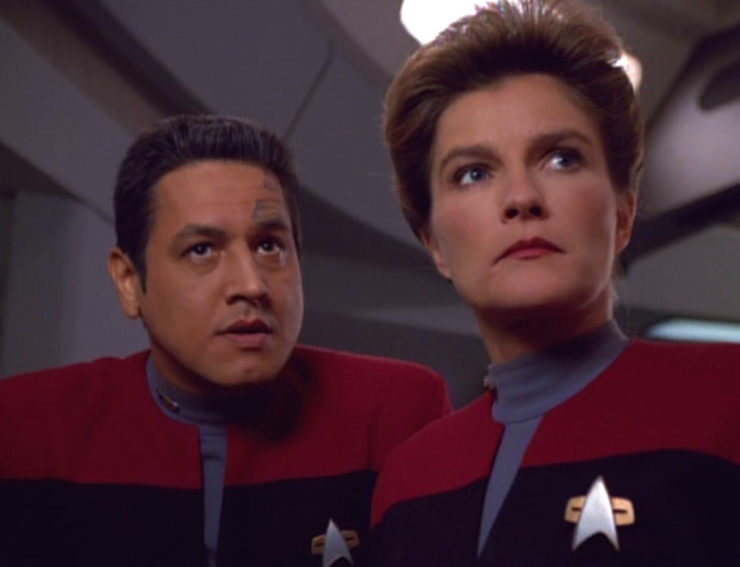Star Trek: Voyager Second Season
Original air dates: September 1995 – May 1996
Executive Producers: Rick Berman, Michael Piller, Jeri Taylor
Captain’s log. In its second year, Voyager had settled into a routine of being a ship of Starfleet personnel that were trying to get home, but also doing the usual seeking out of new life and new civilizations and all that jazz. The Starfleet-Maquis conflict was barely even acknowledged, and while there were still some supply issues, they were never particularly overwhelming, simply one of many problems to be occasionally dealt with.
Two of the three recurring antagonists created in the first season continued to be thorns in the ship’s side. One was the Kazon, from the Ogla attacking Chakotay’s shuttle in “Initiations” to the Nistrim taking over the ship in “Basics, Part I,” with lots of drama in between, what with Seska working with the Nistrim and Jonas working covertly on the Kazon’s behalf on board ship.
The other was the Vidiians, who continued to be antagonistic in “Deadlock” and “Resolutions,” but showed some signs of friendship in “Lifesigns.” (The third was the Sikarians from “Prime Factors,” who were deemed ineffective, despite that being the best episode of the first season.)
Buy the Book


To Sleep in a Sea of Stars
On top of that, the crew encountered Suspiria, the Caretaker’s mate, mentioned way back in the pilot episode, but she’s not willing to send them home (“Cold Fire”).
Each of the main characters got at least one episode that gave them a spotlight: Janeway in “Resistance” and “Resolutions,” Chakotay in “Initiations,” “Tattoo,” and “Resolutions,” Tuvok in “Innocence” and “Meld,” Torres in “Prototype” and “Dreadnought,” Paris in “Parturition,” “Threshold,” and “Investigations,” Kim in “Non Sequitur,” Neelix in “Parturition” and “Investigations,” the EMH in “Projections” and “Lifesigns,” and Kes in “Elogium” and “Cold Fire.” Plus the ship has its first new arrival: Samantha Wildman announces in “Elogium” that she’s pregnant, and she gives birth to a girl in “Deadlock.”
While there was very little by way of “oooh, can we get home this way?” episodes, there were plenty of touchstones to the Alpha Quadrant, including two planets containing people who’d visited Earth (“The 37’s,” “Tattoo“), Kim living an alternate timeline on Earth (“Non Sequitur“), many crewmembers hallucinating people they left behind (“Persistence of Vision“), the EMH imagining he’s at Jupiter Station (“Projections“), Torres dealing with a smart missile of the Maquis’ that also fell down the Caretaker’s rabbit hole (“Dreadnought“), and the appearance of members of the Q-Continuum, as well as three humans from Earth, including William T. Riker his own self (“Death Wish“).
Highest-rated episode: It’s our first-ever five-way tie for first place! That’s right, five episodes earned a 9 this season: “Resistance,” “Dreadnought,” “Lifesigns,” “The Thaw,” and “Resolutions.”
Lowest-rated episode: Another tie, but only two-way: both the incredibly boring “Twisted” and the incredibly terrible “Threshold” got a 1.
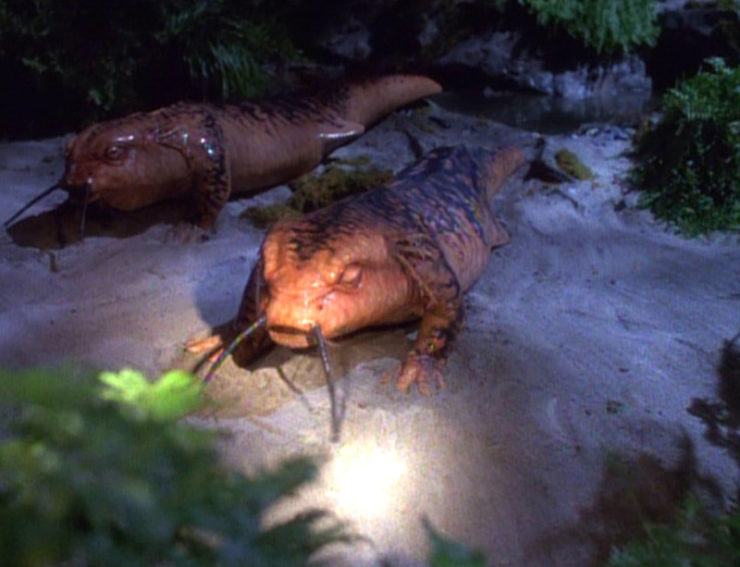
Most comments (as of this writing): “Tuvix” with 138, and it’s not even a contest. The moral dilemma of Janeway and her solution to the melding of Tuvok and Neelix was fodder for a ton of conversation when the episode aired two-and-a-half decades ago, and it remains so now.
Fewest comments (as of this writing): Yet another tie: “Dreadnought” and “Lifesigns“—two of the highest-rated episodes—only got 31 comments each.
Favorite Can’t we just reverse the polarity? From “Maneuvers“: Apparently, simple possession of a transporter module, a piece of technology never mentioned before or since, allows one to utilize transporter technology, and the destruction of that module—which can be sitting out in the open when you’re using it, it would seem—will eliminate that ability. Sure.
Also, Voyager uses the transporter during the climax while shields are up, er, somehow.
Favorite There’s coffee in that nebula!: From “Deadlock“: Both Janeways are determined to make sure that at least one of the two Voyagers makes it out alive, and both are willing to self-sacrifice to save the other.
She’s also the one who’s familiar with the scientific theory that they’ve put to unexpected practical use. I must admit to loving when they go the Janeway-as-science-nerd route…
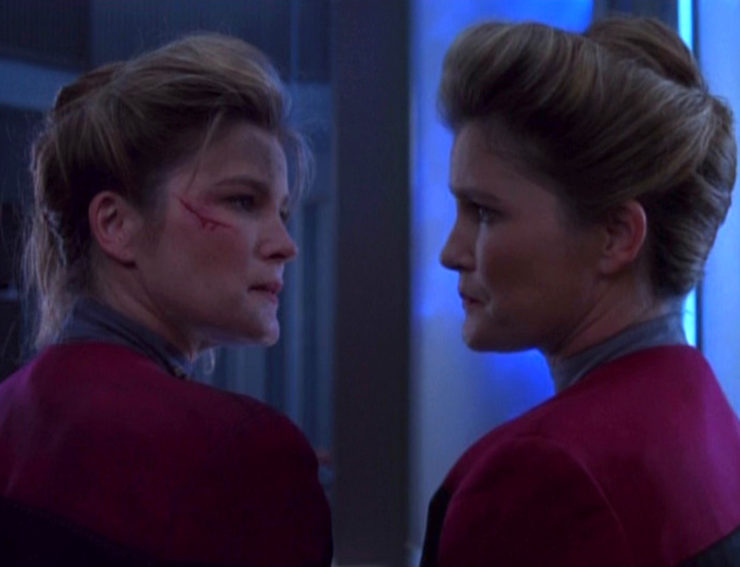
Favorite Mr. Vulcan: From “Alliances“: Tuvok mentions the controversial notion proposed by Spock in Star Trek VI: The Undiscovered Country to ally with the Klingon Empire. Tuvok himself said he spoke out against the idea because of the Klingons’ history of brutal conquest—but the Federation-Klingon alliance has been a cornerstone of the Alpha Quadrant for the better part of a century.
(The punchline, of course, is that, unbeknownst to Tuvok, back home that alliance has fractured and the Klingons and Federation are at war again…)
Favorite Half and half: From “Lifesigns“: After her experiences in “Faces,” Torres is extremely reluctant to help Pel, as she still has nightmares about the experience. Pel’s rather heartfelt apology and explanation of how desperate and awful Vidiians’ lives have become mitigates her anger, and she eventually agrees to it. (Torres never actually mentions that the Vidiians also murdered one of their crewmates, but he wasn’t an opening-credits regular, so it’s not like he’s important or anything.)
Favorite Forever an ensign: From “Non Sequitur“: Apparently Kim believes he’s meant to be lost in the Delta Quadrant and miserable and alone, rather than be a successful member of the Starfleet Corps of Engineers on the verge of promotion while living with the love of his life whom he’s about to marry. Sure.
Favorite Everybody comes to Neelix’s: From “Meld“: When Tuvok needs to test his emotional control, he uses the most annoying person on the ship to test it. We don’t know that it’s a holodeck program until after Tuvok has choked Neelix to death, so our hopes are raised that we’re finally rid of Neelix, but those hopes are then dashed when Tuvok calls for the program to end.

Favorite Please state the nature of the medical emergency: From “Dreadnought“: The EMH is still trying to find a name that suits him, and he and Wildman and Kes talk at length on the subject. Kes is surprised to realize that he’s open to non-human names.
Janeway also totally forgot about him when she gave the order to abandon ship, which annoys him (not without reason).
Favorite What happens on the holodeck, stays on the holodeck: From “Persistence of Vision“: This is the last we see of the Gothic holonovel. So we’ll never know what’s on the fourth floor. (Okay, so it’s totally Lady Burleigh still alive and playing the piano. Still it would’ve been nice to see that…)
Favorite No sex, please, we’re Starfleet: From “Resolutions“: When this episode first aired, the woman I was married to at the time said that you could put a match between Janeway and Chakotay in this episode and it would light on its own. We see them holding hands and giving each other significant looks, and then next time we see them it’s six weeks later, and you just know they were fucking like bunnies the whole time…
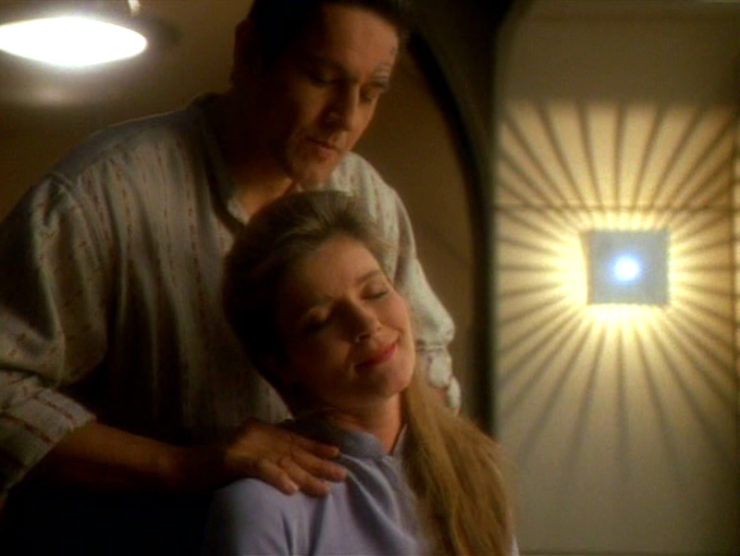
Favorite Welcome aboard: Some truly spectacular guest stars in this season. We’ve got a bunch of very well-known actors taking their turn on Trek and being absolutely brilliant: Sharon Lawrence in “The 37’s,” Joel Grey in “Resistance,” and Michael McKean in “The Thaw.”
The show provides seven new recurring characters this season: Nancy Hower as Samantha Wildman, Simon Billig as Hogan, Raphael Sbarge as Jonas, Marva Hicks as T’Pel, Henry Darrow as Kolopak, Susan Diol as Denara Pel, and Samantha & Emily Leibovitch as Wildman’s infant baby (who will eventually be named Naomi, and later be played by Brooke Stephens and Scarlett Pomer). We also get more of past recurring folk: Martha Hackett as Seska, Anthony De Longis as Culluh, Tom Virtue as Baxter, Stan Ivar as Mark, Judy Geeson as Sandrine, Larry A. Hankin as Gaunt Gary, Angela Dohrmann as Ricky, Michael Cumpsty as Lord Burleigh, Carolyn Seymour as Mrs. Templeton, Thomas Dekker as Henry, and Lindsay Haun as Beatrice.
We’ve got some of the great character actors of the era, as well: Mel Winkler, David Graf, James Saito, John Rubinstein (“The 37’s“), Louis Giambalvo (“Non Sequitur“), Patrick Kerr (“Persistence of Vision“), Gerritt Graham, Maury Ginsberg (“Death Wish“), and Patty Maloney (“The Thaw“).
Various regular Trek guests show up, too, including Tim DeZarn (“Initiations“), Jennifer Gatti, Jack Shearer (“Non Sequitur“), Gary Graham, Norman Large (“Cold Fire“), Alan Scarfe, Glenn Morshower (“Resistance“), Rick Worthy (“Prototype“), Charles O. Lucia (“Alliances”), Marnie McPhail (“Innocence“), Thomas Kopache, and Carel Struycken (“The Thaw“).
Some excellent performances by one-time guests: Dan Kern is superlative as a world leader in “Dreadnought,” child actors Tiffany Taubman, Sarah Rayne, and Tahj D. Mowry are excellent in “Innocence,” and Tom Wright does a spectacular job channeling both Tim Russ and Ethan Phillips in “Tuvix.”
Three TNG regulars turn up, as well: Dwight Schultz as Barclay (“Projections“), John deLancie as Q, and Jonathan Frakes as Riker (“Death Wish“). Schultz and deLancie will both return more than once.
But the two best guests are the late great Aron Eisenberg, wandering across the lot from DS9 to give us arguably the only actually interesting Kazon in “Initiations,” and Brad Dourif being amazingly nuanced and complex as the sociopathic Lon Suder in “Meld” and “Basics, Part I.”
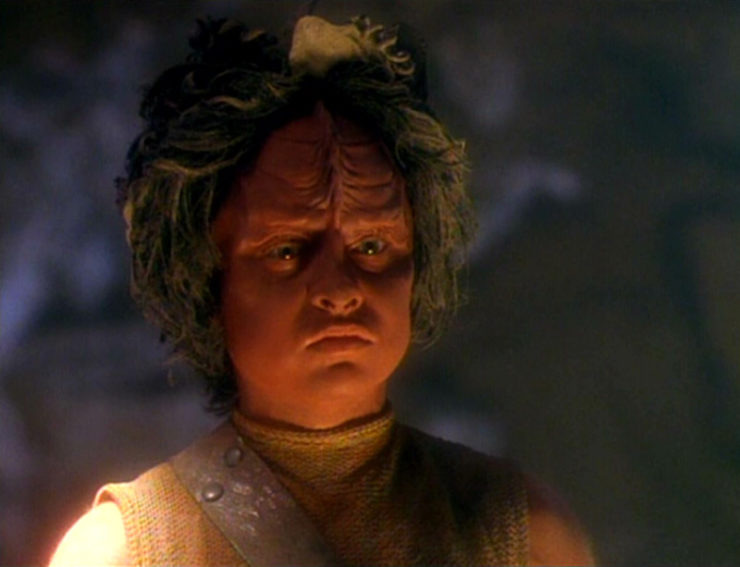
Favorite Do it: From “Threshold“:
“Can you wake him?”
“I don’t see why not. WAKE UP, LIEUTENANT!”
–Janeway requesting that Paris be revived, and the EMH not wanting to waste a perfectly good stimulant.
Favorite Trivial matter: Probably the one for “Resistance,” ’cause I got to talk about my buddies Mike & Kevin.
Set a course for home. “Serving as your captain has been the most extraordinary experience of my life.” This season was a frustrating mix of peaks and valleys.
On the one hand, you had several episodes that were brilliant, mainly because they colored within the lines, as it were. UPN and Rick Berman were determined to keep the show standalone and to avoid long-term consequences, and keep the recurring elements to a minimum, so the episodes that worked best were the ones that worked within those boundaries. All of the ones I rated a 7 or higher were stories that were complete within the hour, with everything back to normal at the end, the story completed. Yes, some of them could have had more long-term consequences, but still, in those cases, there is a satisfying resolution. The strong character study of the Kazon in “Initiations” (which sadly was not properly followed up on—those Kazon would’ve made for interesting antagonists, but they proceeded to make them less interesting after that), the EMH’s mindfuck in “Projections,” the heartbreaking images of home in “Persistence of Vision,” the absolute brilliance of all aspects of “Resistance,” the strong science-fictional adventures of “Prototype” and “Dreadnought,” the beautifully played telepathic insanity of “Meld,” the magnificent love story of “Lifesigns,” the wacky sci-fi goofiness of “Deadlock,” the excellent-despite-the-surprise-reveal-which-was-dumb Tuvok spotlight of “Innocence,” the horror-movie insanity and brilliant guest performance by Michael McKean of “The Thaw,” and the eat-your-cake-and-have-it-too Janeway/Chakotay romance in “Resolutions” (that one a particularly clever way to indulge a particular desire without spoiling the standalone nature of the show).
But there were also far too many episodes that had a scope beyond the 42 minutes of the episode, but were unable to address that scope because the reset button had to be jumped on at the end. So we can’t have anyone staying behind in “The 37’s,” nor can any of the 37’s join the crew (even though the notion that Amelia Earhart would turn down a chance to fly through space is completely unconvincingly absurd). So there’s no long-term (or even short-term!) damage to the ship after it gets all “Twisted.” So Kes’s telepathy charge-up suddenly stops because Suspiria isn’t around anymore even though there’s no reason why it should be that way in “Cold Fire.” So there’s absolutely no impact on Paris and Janeway even though they were turned into salamanders, and they leave their offspring behind to probably die on an alien world in “Threshold.” So Q inexplicably doesn’t send Voyager home even though he can do it with a snap of his fingers in “Death Wish.” So Janeway has to make an awful choice in “Tuvix,” and we see zero of the fallout from that choice.
On top of that, the ship—which has absolutely no proper repair facilities and limited resources—somehow is perfectly fine after suffering catastrophic damage. The worst offenders are “Investigations” (where Jonas cripples the warp drive and their repair station is an ambush site) and “Deadlock” (when Voyager gets the absolute shit kicked out of it).
And their attempt to do an ongoing subplot was a disaster. It started promising, with Paris’s insubordination and Jonas’s betrayal, but the reason for the former is disappointing and the reason for the latter is never given, and the whole thing ends with a massive whimper. Plus, they missed their chance to make it consequential by having it tie into the slambang season finale by having the Kazon’s takeover of the ship be Jonas’s endgame instead of a lame-ass ambush at a repair station.
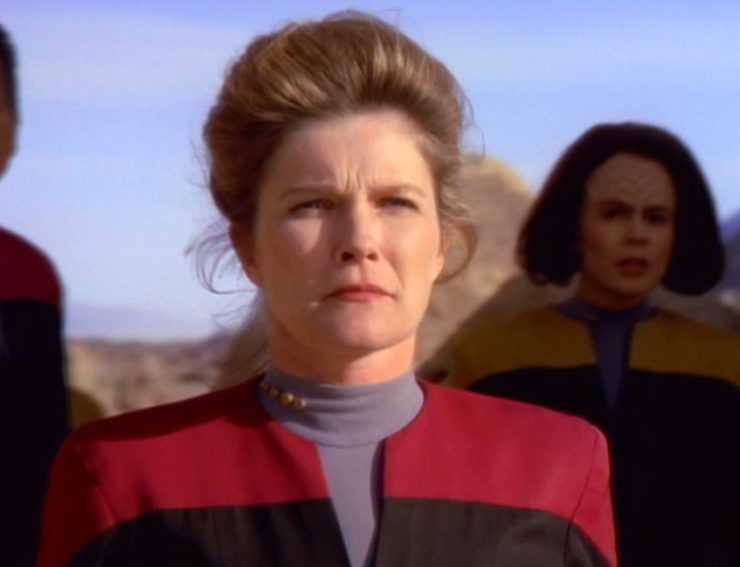
There are also way too many strong premises that are then utterly botched in execution: “Non Sequitur,” “Elogium,” “Twisted,” “Cold Fire,” “Maneuvers,” “Alliances,” “Death Wish,” “Investigations,” “Tuvix,” and the disappointing finale of “Basics, Part I.” (I thought about listing “Tattoo” and “Threshold” here, but, no, those two were DOA thanks to the spectacular ignorance of the writing staff going in, the former with regard to their fake Indian guide, the latter with regard to a completely lack of any kind of understanding of science.)
I said after the first season that my biggest frustration with Voyager was that it didn’t embrace its premise. My biggest frustration with the second season is that they only embraced their externally imposed nature about half the time. It’s unfortunate that their attempts to be ambitious were either badly executed, ruined by the show’s standalone nature, or both, but when they worked within those constraints, it gave us some great stuff.
Warp factor rating for the season: 5
Keith R.A. DeCandido has two collaborative novels coming out in 2020: To Hell and Regroup with David Sherman, the final book in a military science fiction trilogy, and Animal with Dr. Munish K. Batra, a thriller about a serial killer who targets people who harm animals.










